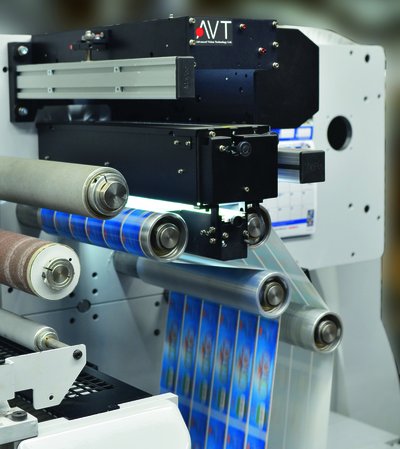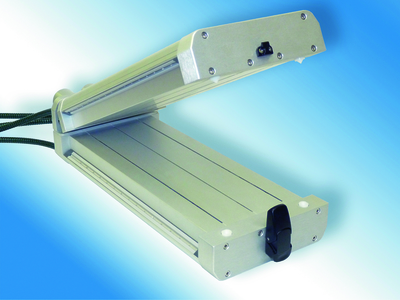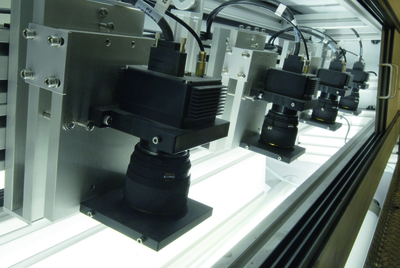Inspection systems from QuadTech
As the substrate passes through the press and print is added, any number of issues can arise that will affect the finished result. Here we look at some of the solutions that can help converters combat problems and reduce costs. By Neel Madsen.
Inspection and web cleaning systems offer huge potential for cost reduction, increased productivity and higher quality. The level of inspection will vary depending on the sophistication of the application, and can be done either in real time on press, be it wide or narrow web, or offline.
Automated inline controls ‘Inline, image-based inspection and colour measurement systems offer a standardised, objective and productive way of ensuring quality consistency, on both narrow as well as wide webs,’ said Randy Freeman, general manager packaging at QuadTech. ‘They reach quality targets faster, reduce start up material waste, give reassurance of accuracy throughout the production run and keep labour costs to a minimum.’ He continued, ‘To meet stringent zero-defect quality standards, 100% inspection is a must. This implies inspection of the whole substrate width, constantly, throughout the entire production run. Cameras detect defects from <0.1 to 0.2 mm across the web, and 0.15 to 0.35 mm in the printing direction.’
A fixed reference is provided by Golden Template comparison, whereby every printed repeat is compared on-the-fly to a master image. This method is more sensitive to slow-growing defects such as register, streaking and colour changes. Furthermore, PDF verification makes structural comparisons between the Golden Template and the customer-approved digital artwork file, providing alerts to set up errors.
A waste management system automatically controls the slitter rewinder speed, waste removal and roll splicing. New tagless defect tracking features use weight to determine waste removal and avoid the need to contaminate a roll with tags.
Also, a central data repository adds traceability and accountability to the workflow. QuadTech’s Data Central audits, stores and generates reports of both current and historical data, enabling trend analysis and defect traceability. Integrated within the IT network, the repository can store job settings, simplifying set up times.
Standardised colour Spectrophotometric measurement, using spectral response and L*a*b* values, provides the optimum standard for describing colour. Inline measurement systems take readings, from many image targets, continuously and throughout the run.
Furthermore, measurement is possible for unsupported, thinner films and papers, as well as transparentand reflective substrates, with the support of a web stabiliser. This comprises ceramic tiles that provide a stable, controlled way of taking spectral colour measurements, without risk of corrugation.
A standard spectral colour measurement procedure developed by QuadTech is enabling standardisation and simplification of the colour preparation stage. It is capable of sharing and processing offline and inline colour data in a common format. This includes inline spectral data obtained from QuadTech’s SpectralCam, ink formulation data from X-Rite and ink dispensing technology from huber group or other ink dispensing system suppliers.
A spectral colour curve is generated for customer-defined colour targets and loaded into the ink formulation software, which formulates a recipe and sends it to the ink dispenser. The ink batch is controlled by a draw down before going to press. During printing, colour targets are compared by the colour measurement system; deviations are captured and reported in delta E values. These are reported automatically by the measurement system, which generates a .CxF file instructing the ink kitchen’s ink formulation software to fine-tune the recipe.
As a result, colour data can be shared in a common format and processed between inline colour measurement and offline colour measurement technology. The packaging printer therefore has an accelerated, assured means of arriving at colour perfection and maintaining it to the final print.
‘The modern inline, spectrophotometric, integrated colour measurement and inspection system has come of age and this is an essential factor in an industry where getting perfect results first time, every time is not a luxury but a given,’ concluded Mr Freeman.
Solutions for all sizes
Erhardt+Leimer offers a made to measure solution for any size of company and workflow application.
For companies and groups of companies with integrated quality departments, there is a network solution with an independent quality control station.
There is also an entry solution into digital inspection workflow with the processing of the inspection reports directly at the cutting machine. This involves loading the digital reports into the Nyscan Roll:Scheduler system on the cutting machine from the Nyscan Web:Inspector 100% inspection system via a network andediting them there.
For security and pharmaceutical applications, the company has a number of 100% inspection solutions for the production of flexible packaging. This includes critical applications, such as the monitoring and inspection of holograms and watermarks in applications such as cigarette packaging, bank notes, and credit cards, ID and pass cards.
‘Our roots lie in the very demanding inspection of reflecting security and pharmaceutical labels’, said Robert Heichele, Nyscan sales manager. ‘Building on this, and in permanent dialog with our customers in the fields of security, consumer labels, food and beverage, and flexible packaging, we have continuously developed our systems to match market requirements and are thus able to offer a suitable inspection solution for virtually all applications.’
 AVT offers the PrintVision/Helios II system
AVT offers the PrintVision/Helios II system
Real time editing
Erhardt+Leimer has recently extended its product group by adding a new module to the digital workflow for 100% print inspection systems with the new ‘real time editing’ module (RTE). The procedure adopted up to now, editing the roll reports created by the 100% inspection systems on the printing presses after completion of the roll or the job at a separate workstation, can now be omitted completely, said the company.
With the RTE module, the press operator has direct access to the roll report of the active Nyscan inspection system and can process the report in real time. In parallel with this, the number counters for the total, good and waste quantity are updated continuously. In addition, the printer always has a display of the actual number of good labels, running meters or repeats that will be available after cutting, avoiding ‘over production’ and reducing waste. The material and set up costs are also reduced. This optimisation of the production run can potentially release press resources to be used for other jobs.
First introduced at Labelexpo Europe this year, the new module is also offered as a retrofit to all existing Nyscan Web:Inspector 100% inspection systems.
 Robert Heichele, Nyscan sales manager at Erhardt+Leiner
Robert Heichele, Nyscan sales manager at Erhardt+Leiner
Lenticular inspection
Advanced Vision Technology (AVT) Ltd introduced a new 100% automatic Hologram Inspection System at Labelexpo Europe. Combining traditional print inspection technologies with holographic foils inspection and hologram print applications, it is comprised of a combination of illumination and optics developed over the last two years.
‘Our new Hologram Inspection System has been two years in the making, and is the result of AVT building upon its established industry- leading vision inspection technology,’ said Amir Dekel, vice president of corporate marketing.
Another new introduction is the next generation of its PrintFlow print quality database, PrintFlow 2.0, which has an upgraded user interface, a new roll map display and expanded production management capabilities.
For 100% inspection, the company has the PrintVision/Helios II system, a solution that inspects all print technologies both on press and rewinder. There are a range of additional tools and modules available for increased versatility, including SpectraLab, which features inline spectral measurements according to international ISO standards. This provides absolute colour measurements, L*a*b* colour scale information and density readings.
The Helios systems can also be equipped with another newly introduced product, which was developed in cooperation with Esko to integrate with Automation Engine 12. ZeroSet links the pre-press workflow with the automatic inspection system via JDF and enables the pre-press operator to identify critical areas to be checked before the job goes on press.
Enhanced performance
eltromat has installed almost 600 of its iPQ_solutions (increasing Productivity and Quality solutions) worldwide since 2010.
This modular product combines web viewing, 100% inspection, spectral colour measurement and workflow depending on the customer’s needs. This means that the converter can initially install a simple web viewing system with sample inspection, but easily upgrade to 100% inspection if needed without having to buy and install a new system. The company presented the next generation of its 100% inspection system at Labelexpo Europe.
twin_check 2.0 features new RGB line-scan cameras equipped with triple line sensors with 4096 pixels each and a line frequency of 85 MHz. This means that the camera output signal is no longer interpolated, which results in better resolution and image quality. Another improvement has been achieved with regard to the illumination. The development was focused on special requirements of package printing, so that now even reflective materials can be inspected without false alarms.
Even with its enhanced performance, twin_check 2.0 is considerably smaller and lighter.
 Meech’s CyClean web cleaning system
Meech’s CyClean web cleaning system
Therefore, less space is required within the printing press and the integration is much simpler. Additionally, the camera module can be mounted either horizontally or vertically as required for the most efficient installation.
For spectral colour measurement, eltromat has ‘inco_check’ which provides fast and exact real time measurements of all colour values over the whole production progress. This allows for early adjustments in case of colour problems and the further reduction of waste. It can be integrated flexibly into the system as part of the individual iPQ_solution.
Automatic label inspection
Nikka Research Deutschland GmbH specialises in automation, inspection and measurement solutions. Its Alis M1 is a basic inspection system for slitter rewinders available for 330 and 440 mm web widths, running at speeds up to 200 m/min. The Alis L-series can be mounted on press or rewinder for automatic inspection for printing defects like colour change, broken or missing print, ink spots and streaks, register change, matrix, splices, missing labels. It is available in web width up to 760 mm and can be customised with barcode, variable data and OCR modules.
The company showed its technology at Labelexpo with a Prati Saturn Plus TE 330 label slitter inspection rewinder equipped with the Alis L1C-330 camera demonstrated on the Prati stand. Other inspection applications were demonstrated in cooperation with its partners Durst, Grafotronic and Rotoflex.
Ivan Bonev, chief executive officer, said, ‘Our new glass cockpit platform with two multi touchscreens and gesture control showed brilliant quality images on the Prati Saturn rewinder and attracted numerous visitors. Visitors also complemented the one touch setup of our smallest camera, the Alis M1.’
‘Through our cooperation with Nikka we are able to offer customers a turnkey product, with 100% control and complete finishing processes for self adhesive labels, at a low level of investment, and for brand owners, label products complying to quality standards of the specific reference segment,’ commented Chiara Prati, sales manager at Prati.
Keeping it clean
Maintaining a clean web as it passes through the press is another challenge for converters. Meech has a range of web cleaning products which include features that offers cost and energy savings.
A double-sided blow and vacuumbased web cleaning system which flows contaminants into an inline filter unit, the CyClean is Meech’s first non-contact system designed especially for the narrow web industry and is suitable for both singleand double-sided cleaning. It is the fourth in the company’s series of web cleaning products and the compact system has a clamshell design that is ideal for coating, labelling and laminating applications.
The technology is based on fundamental aerodynamic and fluid dynamic principles, and combined, these deliver a very high cleaning level while requiring practically no maintenance.
The CyClean is composed of a cleaning manifold, 4x active static control AC bars and an air-handling unit (AHU). The AHU, which improves airflow efficiency and allows easy removal and collection of contaminants, also features an F8 grade washable ‘labyrinth’ filter, which reduces the chances of premature blockage in the airflow system.
With specially designed slotted air chambers that direct a constant stream of air on both sides to maximise cleaning efficiency, the system can remove and extract contamination down to 0.5 micron. It has a small footprint, which enables fitting into confined spaces eliminating the need to extend the web path.
The presence of ionising bars on entry and exit sides provide integrated static control offering a thorough, long lasting cleaning process. The bars neutralise all static charges on the web and ensure easy breakdown of the bonds holding contaminants to the web, whilst the risk of re-attracting contaminants to the cleaned web surfaces is also significantly reduced.






